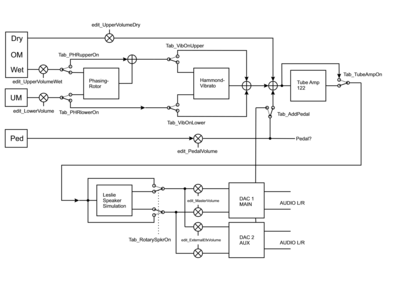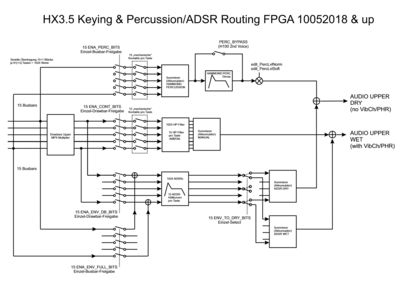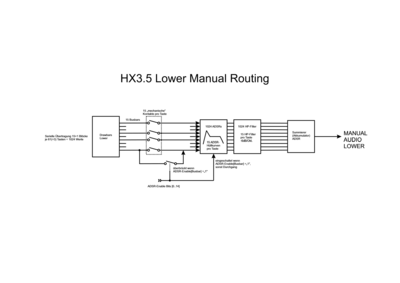HX3.5 Backgrounder: Unterschied zwischen den Versionen
Bovist (Diskussion | Beiträge) K (→Preface) |
Bovist (Diskussion | Beiträge) KKeine Bearbeitungszusammenfassung |
||
| Zeile 8: | Zeile 8: | ||
* New Reverb DSP | * New Reverb DSP | ||
* USB MIDI input (internal connector), just add a USB socket | * USB MIDI input (internal connector), just add a USB socket | ||
==Features== | |||
The new much larger HX3.5 FPGA yields a lot of new features to mimic all classic organs - Hammond H100 as well as Wersi, Farfisa, Böhm, Vox Continental etc., along with the legendary HX3 sound you know: | The new much larger HX3.5 FPGA yields a lot of new features to mimic all classic organs - Hammond H100 as well as Wersi, Farfisa, Böhm, Vox Continental etc., along with the legendary HX3 sound you know: | ||
| Zeile 39: | Zeile 41: | ||
USB supports USB MIDI now (all channels except 10 drums). For now, parameter editing is only possible by MenuPanel (122 parameters) or HX3.5 Editor (more than 800 parameters, FTDI USB adator cable needed). | USB supports USB MIDI now (all channels except 10 drums). For now, parameter editing is only possible by MenuPanel (122 parameters) or HX3.5 Editor (more than 800 parameters, FTDI USB adator cable needed). | ||
==Audio Routing== | |||
[[Datei:Hx35_audio_routing.png|400px|thumb|right|'''HX3.5 main routing diagram - click on picture to enlarge''']] | [[Datei:Hx35_audio_routing.png|400px|thumb|right|'''HX3.5 main routing diagram - click on picture to enlarge''']] | ||
HX3.5 does not have configurable audio outputs; instead, an "effect insert" scheme has been implemented. Plain organ signal is routed through various "effects" (if not bypassed): B3 Vibrato, Phasing Rotor, 122 Amp Simulation and Rotary Cabinet Simulation. Each effect may be enabled or disabled. Bass Pedal Signal may be added to 122 Amp input or bypassed to output stage. See Picture (right) for details. | |||
[[Datei:Hx35 upper routing.png|400px|thumb|right|'''HX3.5 main routing diagram - click on picture to enlarge''']] | [[Datei:Hx35 upper routing.png|400px|thumb|right|'''HX3.5 main routing diagram - click on picture to enlarge''']] | ||
[[Datei:Hx35 lower routing.png|400px|thumb|right|'''HX3.5 main routing diagram - click on picture to enlarge''']] | [[Datei:Hx35 lower routing.png|400px|thumb|right|'''HX3.5 main routing diagram - click on picture to enlarge''']] | ||
Version vom 12. Juli 2018, 12:23 Uhr
Preface
Due to many requests I decided to design a HX3.5 mainboard mechanically compatible to HX3.4, so no need for any hardware change (if you don't want to use the new features).
However, some changes apply:
- Additional analog multiplexer connector for up to 64 analog control inputs
- New Reverb DSP
- USB MIDI input (internal connector), just add a USB socket
Features
The new much larger HX3.5 FPGA yields a lot of new features to mimic all classic organs - Hammond H100 as well as Wersi, Farfisa, Böhm, Vox Continental etc., along with the legendary HX3 sound you know: The new high-performance reverb DSP is capable of producing additional GM voices for piano, vibraphone etc. (optional licence basis). GM voices may be routed to lower manual or pedal also. Here's a list of all new features:
- Support of up to 15 busbars per manual as well as pedal. Higher 6 busbar are routed as "mixtures" to additional 3 drawbars. Busbar mix to each drawbar is adjustable, as well as harmonic (for example 16/27' or 4/5', up to 1/4', or even 10 2/3')
- Any busbar of upper/lower manual may be routed to its own ADSR/VCA envelope circuit instead of "mechanical" contacts (FPGA contains nearly 1000 ADSR/VCA circuits for each manual) for polyphonic percussion on selectable drawbars, sustain or just noiseless "electronic" keying
- "Second Voice" feature as found on Hammond H100 (particular drawbars routed to Vibrato/Chorus, others "dry")
- Additional "electronic" vibrato/chorus/ensemble circuit like Wersivoice or Böhm Phasing Rotor, may also be used and parametrized as additional "Celeste" Vibrato for Hammond H100. Simulation of three TDA1022 CCD delay ICs, adjustable modulation and audio mix for each.
- Loadable generator wavetables for non-Hammond organs, from pure sine to cheesy or sawtooth-like sounds. Each generator octave may have its own waveform.
- Different loudness curves or linear mode for swell pedal
- Bass pedal up to 61 keys, full ADSR envelope as on manuals (always on)
- Up to 15 drawbars per manual, either 4 or up to 15 pedal drawbars, additional 4 drawbars for ADSR envelope plus one "harmonics decay" drawbar per manual (adjusts non-simultaneous decay of harmonics for a decent string bass effect)
- Volume drawbars for tube amp gain, volume, tone (as before), plus separate upper, lower and pedal volumes
- Deleted "Output Configuration" menu. Instead, digital audio "Inserts" act as below. Output A/B select button becomes "Add pedal to tube amp". When off, pedal signal is post-mixed to digital output.
- 16 Buttons/switches as found on mk4 (despite Common Presets, which are no longer supported), plus: 8 Buttons for Wersivoice/Phasing Rotor setup, 2x 12 Buttons for routing a drawbar to ADSR envelope,1 Button for "Second Voice" effect, 4 Buttons for effect "Inserts" (tube amp, rotary speaker sim, PhasingRotor/Wersivoice to lower and upper)
- Generator size adjustable from 72 to 96 notes
- Separate (de-)tuning of each generator note for emulation of Conn and other theater organs
- Firmware and FPGA update by SD Card (external slot) or on-board Micro SD card, very dependable, no need for an update application
- Persistent EEPROM basic settings (user name, licences, scan configuration etc.), will not overwrite on update
- Scripts (human-readable text files) running from SD Card to set any amount of parameters (i.e. for "overall organ type" presets), selectable from MenuPanel
- Support for SysEx communication, no need for USB connection (may still be used, though)
- New menu behaviour for faster scrolling and easy parameter changes (114 entries)
- All parameters may be controlled by MIDI without any buttons/drawbars connected
HX3.5 mainboard is compatible with all older accessories (even drawbar boards), but a new drawbar concept is in queue which supports up to 64 analog inputs. The new drawbar assembly design will contain own multiplexers, as the new design supports up to 64 drawbars or potentiometers (12 drawbars per manual/pedal plus additional controls). This cleans up wiring, as only one 10-wire bus cable is needed to connect them (up to 64 analog inputs and 64 switches/buttons possible). With the new design, all drawbars are connected "daisy-chained" in a row by 10-wire flat ribbon cables, so there is no need for special MPX type drawbar boards to support 2 DB sets per manual.
The new DB design was mandatory for connecting more drawbars per manual (as on H100 for instance) as well as additional ADSR/Volume drawbars. DB boards will be available in groups or 6 (Pedal/Sustain, ADSR control, Volume control), 2x6 (H100-type organ manuals) or 9 drawbars (classic B3 manuals). It is activated by a special parameter in HX3.5 Editor's "System Init" section.
HX3.5 firmware provides 16 overall presets (complete organ setups), 16drawbar "voice" setups (16 selectable by Preset16 board, 12 selectable by Preset12-2 board) plus 24 piano/bass setups per manual and pedal (selected from a choice of 128 GM voices). It is possible to play the piano/bass voices on all manuals, even on the pedal. Menu system was completely revised to support all new features (ADSR control, ADSR enables, Wersivoice/PhasingRotor setup, internal effect inserts, SD card file selection).
USB supports USB MIDI now (all channels except 10 drums). For now, parameter editing is only possible by MenuPanel (122 parameters) or HX3.5 Editor (more than 800 parameters, FTDI USB adator cable needed).
Audio Routing
HX3.5 does not have configurable audio outputs; instead, an "effect insert" scheme has been implemented. Plain organ signal is routed through various "effects" (if not bypassed): B3 Vibrato, Phasing Rotor, 122 Amp Simulation and Rotary Cabinet Simulation. Each effect may be enabled or disabled. Bass Pedal Signal may be added to 122 Amp input or bypassed to output stage. See Picture (right) for details.


